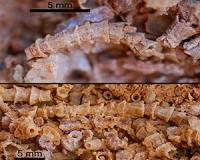| . |  |
. |
Chicago IL (SPX) Apr 06, 2010 Paleontologists can't always get what they want, to paraphrase the Rolling Stones, but sometimes they can get what they need, according to a study that will appear in the May issue of the American Naturalist. The fossil record captures both the broad sweep of evolutionary changes in life on earth as well as ecological responses to shorter-term local and regional environmental shifts. And yet the amount of variability seen among successive fossil assemblages tends to be low compared to that ecologists see over shorter time periods. This suggests that communities are extremely resilient or resistant to change over decades to centuries. In the American Naturalist article, University of Chicago paleontologists Adam Toma�ov�ch and Susan Kidwell used data on living and fossil communities to explore where the low variability in fossil assemblages comes from. Does it come from the natural "time averaging" of skeletal remains that occurs during postmortem accumulation, or from biological processes actively maintaining a particular community composition? Processes in the latter category include strong species preferences for particular niches that may enable them to avoid extinction owing to high growth rates at small population sizes, or the buffering of population growth during unfavorable times. On most seafloors, lake bottoms and land surfaces, however, sediment accumulates quite slowly compared to the rates at which local animal populations generate skeletal remains. Multiple generations of skeletal remains may therefore become mixed within a single fossil assemblage. "Samples from a series of such time-averaged fossil assemblages are thus very different from the snapshots that come from repeatedly sampling a living community," said Toma�ov�ch, a postdoctoral scientist in Geophysical Sciences at UChicago. Simulating the effects of time-averaging on living communities from a Texas lagoon and an east African lake, Toma�ov�ch and Kidwell, the William Rainey Harper Professor in Geophysical Sciences, found that low temporal variation in species composition can be produced or reinforced by time averaging alone. Typical paleoecological data will thus seem to support models of local community stability, whether those communities have actually been stable. "Fossil assemblages are, in most cases, the only source of information about past ecosystems unaffected by human disturbance," Toma�ov�ch said, "and so it is important that we evaluate all factors that might affect their ability to record rates of change. Post-mortem processes that might bias assemblages toward under-estimating past variability are especially important." On the positive side, Toma�ov�ch and Kidwell note that although many fossil assemblages will be too time-averaged to discriminate variability generated by biological processes operating at small spatial scales (approximately a meter) -such as competition or predation-prey interactions-they excel at capturing the larger picture, such as the identities and relative abundances of species in the regional diversity pool that local communities draw upon. The composition of that pool is determined by speciation, extinction and biogeographic processes that are usually extremely challenging to measure using the limited spatial and temporal scope of conventional biological sampling. "It's a matter of scale," Kidwell said. "The fossil record can't give us everything we want at the fine scale, but for some questions, we can get what we need." "The effects of temporal resolution on species turnover and on testing metacommunity models," Adam Toma�ov�ch and Susan Kidwell, The American Naturalist, May 2010.
Share This Article With Planet Earth
Related Links University of Chicago Explore The Early Earth at TerraDaily.com
 New Fossil Species Found In Spain
New Fossil Species Found In SpainMadrid, Spain (SPX) Apr 01, 2010 In the '80s, Spanish researchers found the first fossils of Cloudina in Spain, a small fossil of tubular appearance and one of the first animals that developed an external skeleton between 550 and 543 million years ago. Now palaeontologists from the University of Extremadura have discovered a new species, Cloudina carinata, the fossil of which has preserved its tridimensional shape. "Cloud ... read more |
|
| The content herein, unless otherwise known to be public domain, are Copyright 1995-2010 - SpaceDaily. AFP and UPI Wire Stories are copyright Agence France-Presse and United Press International. ESA Portal Reports are copyright European Space Agency. All NASA sourced material is public domain. Additional copyrights may apply in whole or part to other bona fide parties. Advertising does not imply endorsement,agreement or approval of any opinions, statements or information provided by SpaceDaily on any Web page published or hosted by SpaceDaily. Privacy Statement |